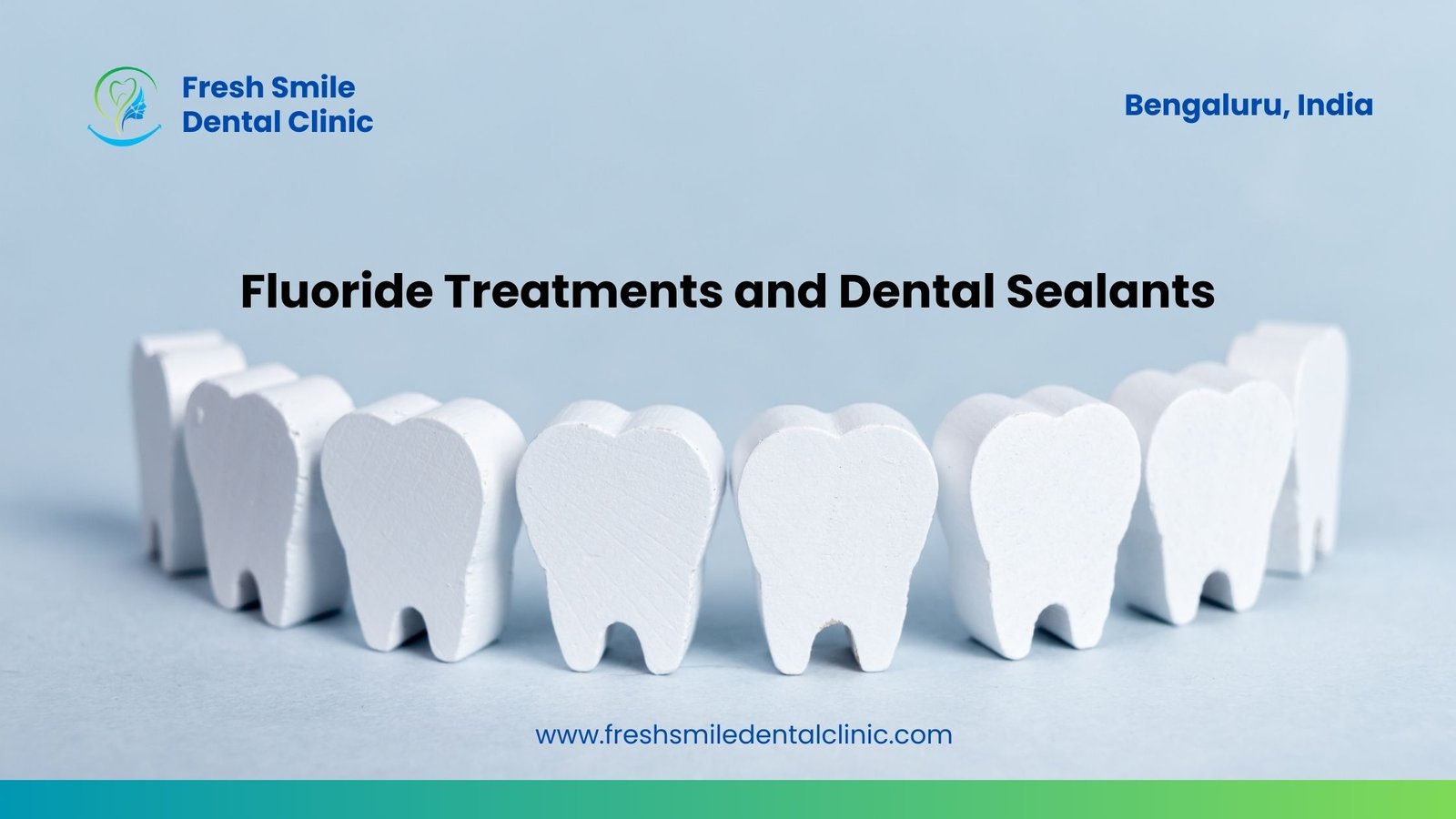Fluoride Treatments and Dental Sealants: Against Tooth Decay in Kids
Introduction
Preventing tooth decay and cavities in pediatric patients is of paramount importance to ensure a lifetime of good oral health. Two highly effective preventive measures, fluoride treatments and dental sealants, offer valuable protection against tooth decay. In this guide, we will explain the benefits of fluoride treatments and dental sealants in preventing tooth decay and cavities in children.
Understanding Tooth Decay
The Role of Bacteria
Tooth decay is primarily caused by harmful bacteria that feed on sugars and produce acids, which erode tooth enamel. Children are particularly vulnerable to tooth decay due to their developing teeth and sometimes less-than-ideal oral hygiene practices.
Importance of Prevention
Preventing tooth decay in children is crucial because it can lead to discomfort, pain, and complications that may affect their overall health and well-being.
Fluoride Treatments
What Is Fluoride?
Fluoride is a naturally occurring mineral that is found in various sources, including water, soil, rocks, and some foods. It is well-known for its beneficial role in promoting dental health and preventing tooth decay. Fluoride works by strengthening tooth enamel, the outer layer of teeth, and making it more resistant to acid attacks from bacteria and certain foods and beverages.
Here are some key points about fluoride:
- Tooth Decay Prevention: Fluoride helps prevent tooth decay, which is the process of enamel erosion and the formation of cavities. It does this by remineralizing areas of enamel that have been weakened by acid exposure. Fluoride can also inhibit the growth of harmful bacteria in the mouth.
- Fluoridated Water: Many communities add fluoride to their public water supplies, a practice known as water fluoridation. This has been a highly effective public health measure in reducing the prevalence of tooth decay, especially in areas with limited access to dental care.
- Fluoride Toothpaste: Fluoride is a common ingredient in toothpaste. Brushing with fluoride toothpaste helps deliver fluoride directly to the teeth, strengthening enamel and protecting against cavities.
- Professional Fluoride Treatments: Dentists and dental hygienists often apply fluoride varnishes or gels during dental visits, especially for children and individuals at higher risk of cavities. These professional treatments provide a concentrated dose of fluoride to further protect teeth.
- Fluoride Supplements: In some cases, healthcare providers may recommend fluoride supplements, such as tablets or drops, for individuals who live in areas with low fluoride levels in their water supply or who have specific dental health needs.
- Topical vs. Systemic Fluoride: Fluoride can be applied topically (directly to the teeth) or taken systemically (ingested and then incorporated into tooth structure as teeth develop). Topical fluoride is more effective at preventing tooth decay, but both forms can be beneficial.
- Safe Levels: It’s important to use fluoride in safe and controlled levels. Excessive fluoride intake during tooth development in children can lead to a condition called dental fluorosis, which affects the appearance of tooth enamel. This typically occurs when children ingest too much fluoride through sources like fluoridated toothpaste.
Benefits of Fluoride Treatments
- Reinforce Enamel: Fluoride treatments help remineralize and strengthen tooth enamel, making it less susceptible to decay.
- Early Intervention: Fluoride treatments can halt the progression of early-stage cavities, preventing the need for more invasive treatments.
- Cavity Prevention: Regular fluoride applications can significantly reduce the risk of cavities in children.
- Safe and Painless: Fluoride treatments are quick, safe, and painless, making them suitable for children of all ages.
Dental Sealants
What Are Dental Sealants?
Dental sealants are thin, protective coatings that are applied to the chewing surfaces of the back teeth (molars and premolars). These surfaces have natural pits and grooves called fissures, which can be difficult to clean thoroughly with a toothbrush. Dental sealants act as a barrier, filling in these fissures and preventing the accumulation of food particles and bacteria that can lead to tooth decay and cavities.
Here are some key points about dental sealants:
- Preventive Measure: Dental sealants are a preventive measure to protect the teeth from cavities, particularly in children and teenagers. These age groups are most susceptible to developing cavities in their back teeth due to the difficulty of cleaning these areas.
- Material: Sealants are typically made of a plastic resin material that is safe and durable. They are tooth-colored or clear, making them virtually invisible when applied.
- Application Process: The process of applying dental sealants is straightforward and painless. It involves the following steps:
- The tooth’s surface is thoroughly cleaned and dried.
- An etching solution is applied to the tooth to create a rough surface for better adhesion of the sealant.
- The sealant material is then applied in liquid form and allowed to flow into the fissures.
- A special curing light is used to harden and set the sealant in place.
- Durability: Dental sealants can last for several years with proper care. They provide a protective shield over the tooth’s surface, reducing the risk of cavities.
- Who Benefits: Sealants are most commonly applied to the permanent molars and premolars of children and teenagers shortly after these teeth erupt. However, adults who are at risk of developing cavities in their back teeth may also benefit from sealant application.
- Regular Check-ups: Even with dental sealants, it’s essential to maintain regular dental check-ups and oral hygiene practices. Sealants are not a substitute for proper brushing, flossing, and routine dental care.
- Cost-Effective: Dental sealants are a cost-effective preventive measure compared to the expense of treating cavities and dental fillings.
Benefits of Dental Sealants
- Effective Protection: Dental sealants provide an effective shield against tooth decay, particularly in the back teeth where cavities are more likely to develop.
- Painless Application: Applying sealants is a painless and non-invasive procedure that requires no drilling or anesthesia.
- Durability: Sealants can last several years, offering long-term protection.
- Cost-Effective: Preventing cavities with sealants is cost-effective when compared to the expense of treating cavities and their potential complications.
The Process of Receiving Fluoride Treatments and Dental Sealants
Fluoride Treatments
- Cleaning: The dentist or dental hygienist cleans the teeth to remove any debris or plaque.
- Application: A fluoride gel, varnish, or foam is applied to the teeth with a brush or tray.
- Waiting Period: The child is asked not to eat, drink, or rinse for a specified time to allow the fluoride to penetrate the enamel.
- Rinse: After the waiting period, the child can rinse their mouth.
Dental Sealants
- Cleaning: The dentist cleans and dries the teeth.
- Application: The sealant material is applied to the chewing surfaces of the molars.
- Hardening: A special light may be used to harden the sealant.
- Check and Adjust: The dentist ensures the sealant has properly adhered and makes any necessary adjustments.
The Importance of Regular Check-ups
Monitoring and Maintenance
Regular dental check-ups are essential to monitor the effectiveness of fluoride treatments and the condition of dental sealants. The dentist can reapply fluoride and repair or replace sealants as needed.
Conclusion
Fluoride treatments and dental sealants are powerful allies in the battle against tooth decay and cavities in pediatric patients. By strengthening tooth enamel, preventing acid attacks, and creating protective barriers, these preventive measures offer children the opportunity for a lifetime of healthy and beautiful smiles. Consult with your child’s dentist to determine the most suitable preventive strategies to ensure their oral health and well-being. Remember, a little prevention today can save a lot of dental trouble in the future.
Read Also:
Teeth and Gum Care for Infants and Toddlers.
Crown and Bridge Restorations.
Managing Dental Anxiety in Children.
Fluoride Treatments and Dental Sealants: Against Tooth Decay in Kids.
Treating Gum Disease with Laser Therapy.
Precision and Accuracy in Laser Dentistry.
11 things an adult can do to maintain good oral health.
11 things that makes your teeth weak.




